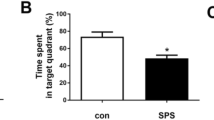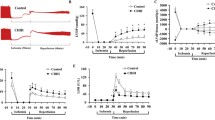Abstract
The present study aimed to elucidate the mechanism of myocardial damage induced by simulated transport stress. Sprague–Dawley rats were subjected to 35 °C and 60 rpm (0.1×g rcf) on a constant temperature shaker. The blood samples were prepared for detection of epinephrine (E), norepinephrine (NE), atrial natriuretic peptide (ANP), brain natriuretic peptide (BNP) and serum cardiac troponin T (cTNT); myocardium samples were prepared for morphological examination and signaling protein quantitative. The result showed that plasma norepinephrine (NE) and epinephrine (E) concentrations increased in all stressed groups (P < 0.01). Levels of serum cardiac troponin T (cTNT) were elevated in both the S2d (P < 0.05) and S3d groups (P < 0.01). The concentration of plasma BNP was increased significantly in S3d group (P < 0.05); the difference in ANP was not remarkable. Morphological observation demonstrated obvious microstructure and ultrastructure damage after simulated transport stress. There was also a significant increase in the number of TUNEL-positive cardiomyocytes in stressed hearts. Western blot analysis found that the mitogen-activated protein kinase (MAPK) pathways were activated by strengthening phosphorylation of ASK-1, JNK, P38 and ERK in rat myocardial tissue after simulated transport stress (P < 0.05, P < 0.01). In addition, the ratio of pro-apoptotic Bax and anti-apoptotic Bcl-2 proteins was increased in stressed rats (P < 0.01), and the amount of cleaved-caspase3 increased in all stressed rats (P < 0.01). The expression of cleaved-caspase9 protein was also elevated in S2d and S3d groups (P < 0.01). Consequently simulated transport stress induced obvious myocardial damage, which may be attributed to the activation of caspase 9-mediated mitochondrial apoptotic pathway and MAPK pathways.





Similar content being viewed by others
References
González LA, Schwartzkopf-Genswein KS, Bryan M, Silasi R, Brown F (2012) Relationships between transport conditions and welfare outcomes during commercial long haul transport of cattle in North America. J Anim Sci 90:3640–3651
Obernier JA, Baldwin RL (2006) Establishing an appropriate period of acclimatization following transportation of laboratory animals. ILAR J 47:364–369
de Kloet ER, Joëls M, Holsboer F (2005) Stress and the brain: from adaptation to disease. Nat Rev Neurosci 6:463–475
McEwen BS, Seeman T (1999) Protective and damaging effects of mediators of stress. Ann N Y Acad Sci 896:30–47
Wan CR, Yin P, Xu XL, Liu MJ, He SS, Song SX, Liu FH, Xu JQ (2014) Effect of simulated transport stress on the rat small intestine: a morphological and gene expression study. Res Vet Sci 96:355–364
Abraham J, Mudd JO, Kapur NK, Klein K, Champion HC, Wittstein IS (2009) Stress cardiomyopathy after intravenous administration of catecholamines and beta-receptor agonists. J Am Coll Cardiol 53:1320–1325
Baines CP, Molkentin JD (2005) STRESS signaling pathways that modulate cardiac myocyte apoptosis. J Mol Cell Cardiol 38:47–62
Mizote I, Yamaguchi O, Hikoso S, Takeda T, Taneike M, Oka T, Tamai T, Oyabu J, Matsumura Y, Nishida K, Komuro I, Hori M, Otsu K (2010) Activation of MTK1/MEKK4 induces cardiomyocyte death and heart failure. J Mol Cell Cardiol 48:302–309
Cowan KJ, Storey KB (2003) Mitogen-activated protein kinases: new signaling pathways functioning in cellular responses to environmental stress. J Exp Biol 206:1107–1115
Zhu W, Zou Y, Aikawa R, Harada K, Kudoh S, Uozumi H, Hayashi D, Gu Y, Yamazaki T, Nagai R, Yazaki Y, Komuro I (1999) MAPK superfamily plays an important role in daunomycin-induced apoptosis of cardiac myocytes. Circulation 100:2100–2107
Park J, Ann SH, Chung HC, Lee JS, Kim SJ, Garg S, Shin ES (2014) Remote ischemic preconditioning in hemodialysis: a pilot study. Heart Vessels 29:58–64
Feuerstein GZ, Young PR (2000) Apoptosis in cardiac diseases: stress- and mitogen-activated signaling pathways. Cardiovasc Res 45:560–569
Sanchez A, Toledo-Pinto EA, Menezes ML, Pereira OC (2003) Changes in norepinephrine and epinephrine concentrations in adrenal gland of the rats submitted to acute immobilization stress. Pharmacol Res 48:607–613
Schmittinger CA, Wurzinger B, Deutinger M, Wohlmuth C, Knotzer H, Torgersen C, Dünser MW, Hasibeder WR (2010) How to protect the heart in septic shock: a hypothesis on the pathophysiology and treatment of septic heart failure. Med Hypotheses 74:460–465
Costa VM, Carvalho F, Bastos ML, Carvalho RA, Carvalho M, Remião F (2011) Contribution of catecholamine reactive intermediates and oxidative stress to the pathologic features of heart diseases. Curr Med Chem 18:2272–2314
Wittstein IS, Thiemann DR, Lima JA, Baughman KL, Schulman SP, Gerstenblith G, Wu KC, Rade JJ, Bivalacqua TJ, Champion HC (2005) Neurohumoral features of myocardial stunning due to sudden emotional stress. N Engl J Med 352:539–548
Rona G (1985) Catecholamine cardiotoxicity. J Mol Cell Cardiol 17:291–306
Yamada K, Iino S, Isobe S, Kondo T, Izawa H, Inden Y, Yoshikane M, Ikeda N, Hirai M, Sawada K, Murohara T (2012) Relation of plasma catecholamine levels with pulse wave velocity in hypertensive patients compared with normotensive subjects. Heart Vessels 27:493–498
Macheret F, Heublein D, Costello-Boerrigter LC, Boerrigter G, McKie P, Bellavia D, Mangiafico S, Ikeda Y, Bailey K, Scott CG, Sandberg S, Chen HH, Malatino L, Redfield MM, Rodeheffer R, Burnett J, Cataliotti A (2012) Human hypertension is characterized by a lack of activation of the antihypertensive cardiac hormones ANP and BNP. J Am Coll Cardiol 60:1558–1565
Pfister R, Michels G (2013) Lack of activation of the antihypertensive cardiac hormones ANP and BNP in human hypertension. J Am Coll Cardiol 61:900–901
Therkelsen SK, Groenning BA, Kjaer A, Svendsen JH, Boje Jensen G (2008) ANP and BNP in atrial fibrillation before and after cardioversion—and their relationship to cardiac volume and function. Int J Cardiol 127:396–399
Xia L, Weiqiang K (2014) The relationship of plasma BNP, ANP, TNF-α and IL-6 levels to cardiac function in patients with congestive heart failure. J Am Coll Cardiol 64:C189
Nef HM, Mollmann H, Akashi YJ, Hamm CW (2010) Mechanisms of stress (Takotsubo) cardiomyopathy. Nat Rev Cardiol 7:187–193
Latini R, Masson S, Anand IS, Missov E, Carlson M, Vago T, Angelici L, Barlera S, Parrinello G, Maggioni AP, Tognoni G, Cohn JN (2007) Prognostic value of very low plasma concentrations of troponin T in patients with stable chronic heart failure. Circulation 116:1242–1249
Kawahara C, Tsutamoto T, Nishiyama K, Yamaji M, Sakai H, Fujii M, Yamamoto T, Horie M (2011) Prognostic role of high-sensitivity cardiac troponin T in patients with nonischemic dilated cardiomyopathy. Circ J 75:656–661
Kroemer G, Dallaporta B, Resche-Rigon M (1998) The mitochondrial death/life regulator in apoptosis and necrosis. Annu Rev Physiol 60:619–642
Muñoz-Pinedo C (2012) Signaling pathways that regulate life and cell death: evolution of apoptosis in the context of self-defense. Adv Exp Med Biol 738:124–143
Uchida Y, Egami H, Uchida Y, Sakurai T, Kanai M, Shirai S, Nakagawa O, Oshima T (2010) Possible participation of endothelial cell apoptosis of coronary microvessels in the genesis of Takotsubo cardiomyopathy. Clin Cardiol 33:371–377
Frey TG, Mannella CA (2000) The internal structure of mitochondria. Trends Biochem Sci 25:319–324
Fu YC, Chi CS, Yin SC, Hwang B, Chiu YT, Hsu SL (2004) Norepinephrine induces apoptosis in neonatal rat endothelial cells via down-regulation of Bcl-2 and activation of β-adrenergic and caspase-2 pathways. Cardiovasc Res 61:143–151
Hong SH, Jang HH, Lee SR, Lee KH, Woo JS, Kim JB, Kim WS, Min BI, Cho KH, Kim KS, Cheng X, Kim W (2014) Impact of lysophosphatidylcholine on survival and function of UEA-1acLDL endothelial progenitor cells in patients with coronary artery disease. Heart Vessels. doi:10.1007/s00380-014-0473-z
Fu YC, Yin SC, Chi CS, Hwang B, Hsu SL (2006) Norepinephrine induces apoptosis in neonatal rat endothelial cells via a ROS-dependent JNK activation pathway. Apoptosis 11:2053–2063
Takebe K, Nishiyama T, Hayashi S, Hashimoto S, Fujishiro T, Kanzaki N, Kawakita K, Iwasa K, Kuroda R, Kurosaka M (2011) Regulation of p38 MAPK phosphorylation inhibits chondrocyte apoptosis in response to heat stress or mechanical stress. Int J Mol Med 27:329–335
Martinou JC, Youle RJ (2011) Mitochondria in apoptosis: Bcl-2 family members and mitochondrial dynamics. Dev Cell 21:92–101
Yamaguchi O, Higuchi Y, Hirotani S, Kashiwase K, Nakayama H, Hikoso S, Takeda T, Watanabe T, Asahi M, Taniike M, Matsumura Y, Tsujimoto I, Hongo K, Kusakari Y, Kurihara S, Nishida K, Ichijo H, Hori M, Otsu K (2003) Targeted deletion of apoptosis signal-regulating kinase 1 attenuates left ventricular remodeling. Proc Natl Acad Sci USA 100:15883–15888
Hikoso S, Ikeda Y, Yamaguchi O, Takeda T, Higuchi Y, Hirotani S, Kashiwase K, Yamada M, Asahi M, Matsumura Y, Nishida K, Matsuzaki M, Hori M, Otsu K (2007) Progression of heart failure was suppressed by inhibition of apoptosis signal-regulating kinase 1 via transcoronary gene transfer. J Am Coll Cardiol 50:453–462
Ichijo H, Nishida E, Irie K, ten Dijke P, Saitoh M, Moriguchi T, Takagi M, Matsumoto K, Miyazono K, Gotoh Y (1997) Induction of apoptosis by ASK1, a mammalian MAPKKK that activates SAPK/JNK and p38 signaling pathways. Science 275:90–94
Bhattacharya U, Halder B, Mukhopadhyay S, Giri AK (2009) Role of oxidation-triggered activation of JNK and p38 MAPK in black tea polyphenols induced apoptotic death of A375 cells. Cancer Sci 100:1971–1978
Dai Y, Yu C, Singh V, Tang L, Wang Z, McInistry R, Dent P, Grant S (2001) Pharmacological inhibitors of the mitogen-activated protein kinase (MAPK) kinase/MAPK cascade interact synergistically with UCN-01 to induce mitochondrial dysfunction and apoptosis in human leukemia cells. Cancer Res 61:5106–5115
Acknowledgments
This work was supported by grants from Public Service Sectors Agriculture Research Projects (No. 201003060-9/10). We are thankful for the help from the members of CAU-BUA TCVM teaching and research team.
Conflict of interest
The authors declare that they have no conflict of interest.
Author information
Authors and Affiliations
Corresponding author
Rights and permissions
About this article
Cite this article
Wan, C., Chen, Y., Yin, P. et al. Transport stress induces apoptosis in rat myocardial tissue via activation of the mitogen-activated protein kinase signaling pathways. Heart Vessels 31, 212–221 (2016). https://doi.org/10.1007/s00380-014-0607-3
Received:
Accepted:
Published:
Issue Date:
DOI: https://doi.org/10.1007/s00380-014-0607-3




